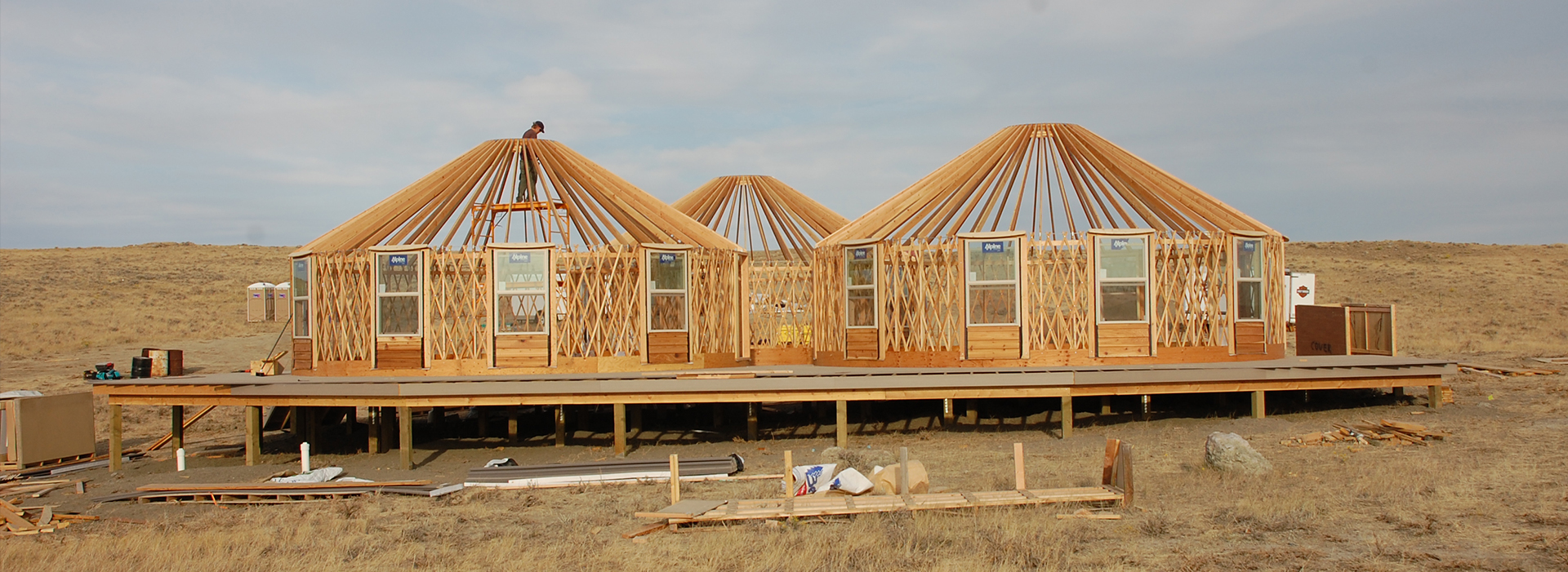There’s a certain romanticism to building your own dream home. Sure, the American dream used to mean Suburban bliss with a manicured yard and the 2 car garage, maybe a second vacation home. For certain folks, this is just a little too boring. Your dream yurt project may have arose out of necessity, conviction, curiosity, daring, or a need to challenge yourself. At Shelter Designs, two of our driving principles are necessity and environmentally friendly design.
One advantage of buying a beautiful Shelter Designs yurt kit is that it is indeed portable. While many folks go on to install all the modern amenities, it is entirely possible to live comfortably in your yurt and then move it at a later date. For those of us that like to have an investment that can adapt with our needs, a yurt can be very appealing.
We often get calls from folks who are looking to move into a new area, and are looking for advice on how to make their yurt dream come true. There are many important considerations. Please see the links below for additional information. This post will be about buying or leasing land.
Buying Land:
Step 1: Put your desired attributes down on a list.
Fresh water, southern exposure, wildlife, good soils, no neighbors, water rights, access to utilities, trees, proximity to town: list all that a ideal piece of land would have. That way when you are out shopping you can check your list, and patiently find that piece of land that is perfect. Better to think it out now! (this could also include the re-sale-ability if your project is short-term)
Step 2: Research!
If you own or are buying land, your yurt plans are limited by the relevant CCR’s, HOA’s, requirements from your county, and your own budget. Finding a local realtor can save you lots of time, as they can request and find out many of these details for you. Having your list of ideal property features (above) will help them to help you find that special place. So will your budget.
Keep in mind that Temporary Membrane structures, not being used as a residence are the easiest type of yurt to permit. If you plan on using your yurt for a business, you may have to beef up your platform to accommodate the added weight of many customers.
County Building Codes and Regulations
Step 3 : Make a Budget
Budgeting your project is very important! Whether you are securing a bank loan with your current home as collateral, paying as you go over the course of multiple years, or borrowing money from family a budget gives you a plan. Utilities tend to be the 2nd most expensive item when putting in a yurt. (after buying land). It makes sense to locate your project as close to utilities as possible if you plan on having these in your yurt. Use this guide to get started budgeting for your dream yurt or get right to calculating your yurt cost.
Other Considerations:
Yurt Site
Your ideal yurt construction site is flat! Sure it’s amazing to be cantilevered out above a valley bottom, but your costs will be greater due to more bracing, materials, and hired help to construct and design. You also will be in the direct sun, and get more wind. Morning sun and afternoon shade will keep your yurt naturally temperature controlled.
Your ideal yurt site will also:
- allow you to bring in utilities you need
- has easy access for building supplies
- and conforms to limitations (easements, HOA’s, proximity to utilities, etc.)
Check out our Yurt Site Selection for more information on the subject!
LEASING LAND:
If you do not own land, and are looking for a land lease: think ahead! As always, put any agreement you reach in writing. (even if you are friends, indeed: this could save your friendship!) As a “tenant” you have certain rights, which can vary by state. Know those rights, and read your lease agreement carefully.
Important!!! Has the property owner found out if their county will “allow” yurts? Considerations worth adding to your potential lease:
Renters rights
Protection from eviction in winter. Since you are moving a whole home, getting a 2-3 month notice is key, especially in places where snow limits most construction projects for 4-5 months
Utilities
Do these exist already? If you are helping bring in any utilities, will this monetary value be taken off the rent?
Access
Most landlords are required to provide reasonable notice for access to the property. Does this mean the inside of your yurt? Adjacent property?
Maintenance
If you have water access or utilities who is responsible to keep this operational, and make timely repairs? ( for instance who pays/or arranges for snow plowing of your road, or a who arranges to fix a plugged road culvert, and what time-frame will problems be dealt with?)
Agreements
There is a saying “good fences makes good neighbors” Are you allowed to have animals, guests, sublease, or develop gardens, etc.? I imagine the fence is good metaphor for good boundaries. Talking these through beforehand will eliminate so many future problems!!
Insurance
Does the property owner have renters insurance? Do you? Fires, floods, and falling trees can be catastrophic. However many insurance companies do not cover, or know how to insure yurts. A general umbrella policy could be best.
For Renters
The last tip: make sure that you construct your yurt platform with easily DE-constructed materials. This means using screws instead of nails, log cabin screw for beams, and most likely pier blocks.
If you buy a SIPS platform, this very portable platform is already meant to piece together. However you will NOT want to apply mastic between your SIPS panel pieces, or on your Bender board. (Mastic is your industrial strength glue provided with your SIPS panels.)
In the case of your interior Yurt build, again use screws, and always be evaluating how easily something can be dismantled. This portable principle should permeate throughout the whole project. For example, we have seen folks use corrugated metal roofing for interior framed wall coverings instead of drywall: this made the yurt much easier to later move.
It is tempting to get very excited about your yurt project, and forget all else…… It is worth considering where you will want to be in 5, 10, 15, 30 years. Thinking ahead can inform your project plans greatly. For example: If you know you are going to be building a traditional log cabin eventually, should your make your deck/platform/foundation extra sturdy, to be used eventually for the log cabin area?
If you are renting, but plan on moving in a couple of years, when you find your permanent yurt site/land, do you really want to help pay to drop power for the landlord to a tune of $5,000 each?
The subject of owning and buying land can be very complex and then you have your local building department that can really help or throw a wrench into your building plans. We have seen customers ask for a list of “yurt” friendly counties. As you can see, there are simply to many moving pieces to be able to provide such a list. Our goal in writing these blog posts is to walk you through the yurt building experience as painlessly as possible!
If you’re ready to find yurts for sale by Shelter Designs or start building your dream yurt so you know the yurt cost upfront, you’re in the right place!


